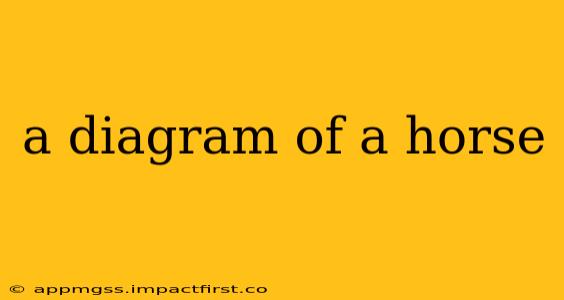While I can't create a visual diagram here, I can provide you with a detailed description that you could use to draw your own diagram of a horse, or to search for existing diagrams online. I'll break it down into sections for clarity.
A Detailed Description for Drawing a Horse Diagram
This description aims to help you create an accurate and informative diagram of a horse. Remember to use appropriate proportions and labels.
1. Head and Neck:
- Head: Draw an elongated head, slightly tapering towards the muzzle. The eyes should be positioned relatively far apart, on the sides of the head. The ears are pointed and mobile, typically placed on the top of the head. The nostrils are large and flared. Show the distinct jawline.
- Neck: The neck is strong and muscular, connecting the head to the shoulders. It should be relatively long and curved, especially in the upper part. Note the flowing mane along the top of the neck.
2. Body:
- Shoulder: The shoulders are sloping and muscular. They are the point where the neck joins the body.
- Back: The back is relatively short and strong.
- Rib Cage: The rib cage is deep and wide, indicating the location of vital organs. It is usually slightly barrel-shaped.
- Belly: The belly is tucked up and fairly slender.
- Hips/Croup: The hips and croup form the rear part of the horse's body. The croup is usually slightly sloped downwards. It is wider and more muscular than the back.
- Tail: The tail is long and bushy, extending from the croup. This is an important distinguishing feature.
3. Legs and Hooves:
- Legs: Horses have four long, slender legs. They should be clearly defined with joints (knees and hocks). Note that the front legs have knees (which bend forward) and the hind legs have hocks (which bend backward).
- Hooves: The hooves are the hardened keratin covering at the end of each leg. They are roughly oval-shaped. Consider drawing the details of the hoof depending on the level of detail your diagram requires.
4. Muscles (Optional, for a more detailed diagram):
Consider highlighting key muscle groups for a more anatomical diagram. This might include the:
- Trapezius: Large muscles extending from the neck to the shoulder.
- Biceps Brachii: Muscles of the upper foreleg.
- Gluteus Maximus: The major muscles of the hindquarters.
Labeling your Diagram:
Clearly label all the parts of the horse, such as:
- Head
- Neck
- Mane
- Withers (the highest point on a horse's back between the shoulder blades)
- Back
- Croup
- Tail
- Flank
- Chest
- Ribs
- Belly
- Forelegs
- Hindlegs
- Stifle (knee of hind leg)
- Hock (ankle of hind leg)
- Fetlock (joint near hoof)
- Hoof
By following this description, you should be able to create an accurate and informative diagram of a horse. Remember to use reference images if needed to ensure accuracy. Good luck!
